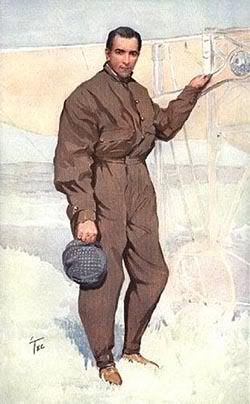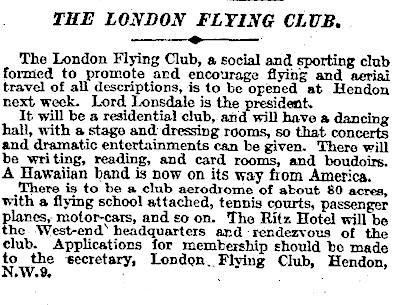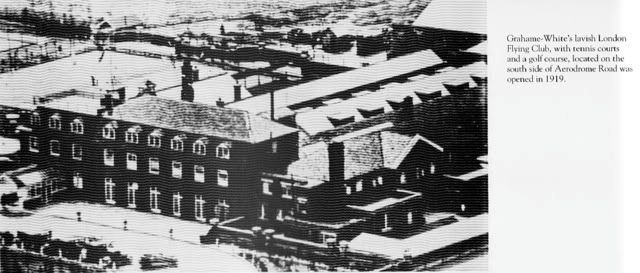This is an interesting story I believe and takes a bit of telling, so please bear with me.
A search of The Times online archive brought up this very interesting reference from May 31 1920:

Suffice it to say this was a bit of a shock. Interesting to note the tense "has been designed".
This is some of what I was then able to find out about Hendon Aerodrome and the London Flying Club:
Claude Grahame - White (1879-1959)
In 1909, he became the first Englishman to gain an aviator's certificate.
He was also the first British pilot to fly at night.
In 1910, as owner of the Aerodrome, he established the first London Flying Club on 207 acres of North London pasture, thus beginning the long history of aviation at Hendon.
In September 1911 the Grahame - White company operated an experimental air mail service for two weeks between Hendon and Windsor. As well commemorating the coronation of King George V, and raising money for charity, the event publicised the possibilities of the aeroplane as a means of transport.
In 1925 Grahame - White's London Flying Club closed to become part of the 400,000 sq ft of property which was leased (short term) to Standard Telephones and Cables Ltd.
Eventually Hendon was sold to the Air Ministry.
Aerodrome Road, separated some driving school garages from the disused Hendon Aerodrome. For a while the old runways were used by the driving school for students to practice their road skills.
During the 1970s, Grahame Park - a mixture of flats, town houses and terraced housing was built on the site.

Grahame-White in Vanity Fair 1911
RAF Hendon
In 1914 the field was taken over by the Admiralty and became a Royal Naval Air Station.
On 1st April 1918 The Royal Flying Corps and the Royal Naval Air Service amalgamated to form the Royal Air Force.
In 1927 the site became an operational RAF station.
On 17th March 1930, 604 Squadron was established:
Hendon remained a major airfield throughout both World Wars, and afterwards it acquired an international reputation as a centre of aviation, through the staging of spectacular aerial pageants.
On 4th November 1957 the airport ceased operations and entered a gradual decline. Eventually, the airfield was swallowed up by the concrete jungle of modern housing, with the Grahame Park Estate covering the majority of the site.
On 15th November 1972, the RAF Museum on Grahame Park Way was officially opened by Her Majesty Queen Elizabeth II.
The Museum occupies two of the original WWI Royal Naval Air Service hangars.
In 1974, Graham - White's London Flying Club's buildings were finally torn down to make way for expansion of The Hendon Police College.
The extensive collection on display includes everything from the basic stick and fabric planes to sophisticated jets.
In 1978, The Battle of Britain Hall was opened, followed by the Bomber Command Hall in 1984.
The Queen Mother was present at a ceremony to mark the official closure of the Hendon Aerodrome on 1st April 1987.
A little bit more about The London Flying Club from 26 June 1919:

Also The Times September 19 1919
"A “SUPER-RANELAGH."
LONDON FLYING CLUB AT HENDON
The London Flying Club, the largest institution of the kind in Great Britain, which has been established at Hendon as a social centre for private aviation, received an informal " house-warming " yesterday. It has been laid out on lines similar to the country clubs in America, the main building especially following this design. The site, on the heights of Hampstead, includes a private aerodrome occupying about 80 acres. Fifty bed rooms, a library, complete catering arrangements, tennis courts, aircraft garages, flying craft for the use of members, and a school for pupils are among the club's amenities. The club is within a quarter of an hour's motor-car run from Golder's Green. Lord Lonsdale is the president of the club, which includes among its vice-presidents Major-General Seely, Lord Weir, the Duchess of Westminster, Lord and Lady D'Abernon, Lord Curzon, Mrs. Winston Churchill, Lord Louth, Lieutenant-General Sir David Henderson, Sir Sidney Greville, Lady Limerick, Lord Lurgan, Lord Ribblesdale, Lady Helmsley, the Princess of Monaco, and the Duke of Rutland. At a luncheon yesterday, Lord Louth, who presided, said that they wanted flying men from abroad to regard the club as their home. Hendon, he declared, had done its full share in the defence of the Empire, 600 aviators having been trained there. Mr. CLAUDE GRAHAME-WHITE said the club was intended to provide the principal air terminus in London, but the aim of the committee was to organize it at the same time as a sort of "super-Ranelagh," catering not only for flying members, but for the devotees of sport generally. In addition to tennis courts, a shooting range, and a gymnasium, they were laying out a golf course. They also had a trout stream, and it was proposed to build a real ice skating rink and an open-air swimming bath. These flying clubs were going to be a very important movement all over the world. The committee had arranged for a service of aeroplanes available to go anywhere at any time. The club will be officially opened on Monday."
So its clear that a course was planned as part of the London Flying Club. But was it built? The next lot of references I found were in regards to a golf professional James B Batley where I found him as representing the London Flying Club in a number of professional events in England and Scotland, including exhibitions with Braid, so he must have been a fair player. So why would a club without a golf course have a golf professional? The answer is that they wouldn't would they, they did have a course, of course!
Next entry is in the property listings and advertises a house for sale, property advert from The Times September 15 1920
"EDGWARE, MIDDLESEX (Hale Lane) - 1/4 mile of G.N.R. Station, the quaint old village, church, ‘bus and tram routes, near Canons Park Golf Course and London Flying Club and Links."
Note the reference to 'Links'.
After I found the next entry from The Times September 8 1920, everything fell into place for me:

I knew that one of the courses listed in Dr Mackenzie's 1923 advertisement with its extensive list of courses he had designed under the London heading was "London Country", but I had been unable to find anything about it in a simple Google Search and assumed it no longer existed. But here was the key that linked it back to Mackenzie and linked the London Flying Club to the London Country Club.

From this point on there a few references to the London Country Club, including some for their professional JB Batley.
Next entry of any relevance is from Feb 1 1926:

Clearly the club was experiencing difficulties and believe this was in regards to owner Grahame-White closing the club to become part of the property leased to Standard Telephones & Cables (STC) in 1925.
By March 31 1926 the golf course of the London Country Club had been taken over by a newly formed members club called Collindale GC.
The Times March 31 1926
"THE NEW COLINDALE CLUB.
A new members' club has been formed, with the title of the Colindale Golf CIub, to take over the course of the London Country Club at Hendon. A new lease has been obtained from the Air Council, and alterations and improvements have been made to the course."
And I could find very little about Colindale GC, except for a number of adverts like this one giving their location and touting for members.

And that's pretty much when the trail goes cold for me, and I suspect that when the RAF took over Hendon to make it an operational RAF station some time in 1926 that the course was acquired and Colindale's lease terminated.
So that's the story I've been able to piece together so far. Mackenzie designed a new course for Grahame-White's London Flying Club in 1919/20 and it was renamed London Country Club in Setember 1920, eventually being taken over by the Colindale GC in 1926 after the London Country Club became defunct.
A nice example of unknown Mackenzie surfacing, only to be found to be already extinct. As the course was around for 6 or 7 years one would hope there are some photos in the contemporary British golf magazines such as Golf Illustrated and Golfing.
I have now found that the RAF Museum at Hendon has a copy of the London Flying Club's prospectus so I have enquired with them about this item - hopefully there may be a reference to the golf course in there and possibly a plan to show where it was. Fingers crossed. I've also made some enquiries about early aerial photographs of Hendon Aerodrome that may show the golf course.
I'v also just found a book on the history of Hendon Aerodrome by David Oliver and it confirms that the London Flying Club did have an 18 hole course, "Situated on the southern side of Airport Road where a separate airfield had been created, the Club featured a lavish sixty-room clubhouse, no less than thirty hard tennis courts, two polo grounds and an eighteen-hole golf course". Here's a photograph of the clubhouse:

Oliver indicates that after Grahame-White closed the club and leased it to Standard Telephone and Cable Ltd, the golf course was leased to Colindale Golf Club. By 1926 Hendon Aerodrome's ownership had passed to the RAF. He does not mention the final fate of the golf course.
Still more to be found out in this story but an interesting start that I've been able to piece together in the last few weeks. I'll be interested to hear any comments and/or suggestions, but it is remarkable that undiscovered Mackenzie courses are still out there. The truth is out there!
cheers Neil